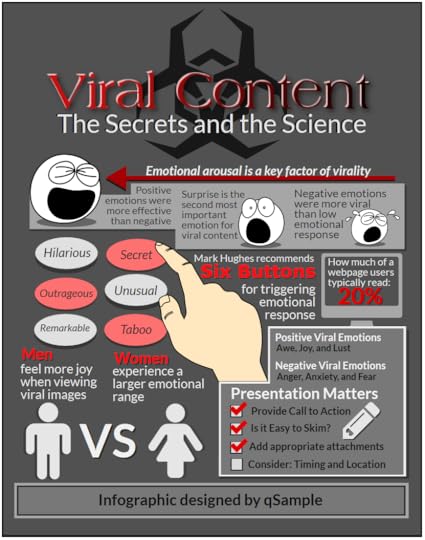Erik Qualman's Blog, page 590
August 20, 2014
Web Design: Style vs Substance

A common error which a lot of websites have become guilty of is the decision of having a stylistic flair or a functional edge. The prominence of either one of these two will vary contingent to the demographic and aim of the website of course.
But should there have to be a choice?
Whether it’s an inadvertent choice or a completely intentional one, it seems to be a case of ‘either/ or’, when it shouldn’t have to be.
Fundamentally, a website should be positioned in the centre of your internet marketing strategy, and a lot of businesses are aware of this- but use this responsibility negligently. Every month, thousands of websites are produced which look visually pleasing but have no substance, and vice versa– are extremely functional but have no customer appeal. The latter would be better for the reputation of your business- if you were to choose one, but ultimately you don’t want your website to lack any of these primary elements. A successful website requires the whole package.
So, what would be the best solution to strike a decent balance between the two, giving your website a substantial foundation and visual appeal?
Primarily, your website needs to be able to execute basic functions, in which will fulfil the aims of your business. Your website needs to be able to complete specific tasks which will help the visitors of your website buy products, join or register to mailing lists, or contact you or a sales representative directly. There is no point in even having a website if it cannot execute simple tasks such as these. The website for this function will be a primary source for potential clients and customers to contact you to inquire further, or even purchase one of your goods outright. 61% of global Internet users research products online; it would be crazy not to cash in on these potential online leads.
Likewise, there is little point in having a website which is heavily ‘decorated’ and which provides no assistance for your customers who want to purchase something from you. Your website does need a design, but rather it be a functional design. However, there is an important difference between design and decoration. It is futile having an abundance of photos and videos if they are not actively doing anything for your business strategy. A website should be design systems not design products; or rather they can showcase design products if that is what your business sells.
A way to get this balance right online, without detracting from the work you do to keep your company alive is to seek help from a professional. Although this may not be your priority in terms of your monthly budget, online branding is very important. Companies such as Big Fork, who specialise in web design in Norwich can help you streamline your website.
In today’s market, the internet means the consumer is confronted with an abundance of choice from entering a simple search term – and your business only has a few seconds to make a good first impression. Professional companies can help you look the part, as well as play an important part in your professional field. If your website, product and brand don’t look the part, it’s likely you’ll lose out to a competitor who has taken the time to invest in their branding and aesthetic appeal. Initially, it may be difficult for you to justify the large sums of money required for services like high end designers or photographers – often because it feels like something you could do yourself. Have faith that your investment will pay off in the long run – websites and brand designs that are made by amateurs, look amateur.
Professionals understand the market and should be able to easily communicate your brand– they do it every day, you may know your business but they know design.
So if the question ever comes up, ‘style or substance?’ in regards to web design, shut down that question straight away. A decent balance of both and you’re all good to go. Happy web designing!
This article was written by Chloe Hashemi. Chloe is a recent English Literature graduate from the University of East Anglia. She enjoys writing about film and social media.
[image error]
The Science Behind a Compelling Social Media Campaign

“Setting up a social media campaign is a piece of cake,” said no marketing professional ever. When it comes to social media-based campaigns, it involves a lot more than just posting content and waiting for the likes and comments to rack up. It involves meticulous planning, endless analysis, and a true understanding of what makes your audience tick.
When you design a campaign to specifically work within the realm of social media, you’re dealing with a lot of unknown factors. You may be thinking:
I know we have a great concept and good content ideas, but will anyone care about what we’re saying?
Did I miss a huge opportunity to connect with more people and spread the campaign further?
If our campaign does take off—and dare we say, go viral—can I handle the huge influx of social media work?
The answer to all these questions can be, “yes!” if you follow these tips:
Everyone Loves a Good Story
Our brains are wired for the elements of a story. We’re automatically drawn to the problem, climax and solution flow of stories, and it’s even more powerful if there’s an emotional connection. That’s why rich content posts, such as photos and videos, always bring in more engagement than posts that consist of plain information and facts. The aim is to tell the most complete story in the most compelling way possible (using imagery, sound and other stimuli) in the short amount of time you have to captivate someone’s attention on a newsfeed.
And when it comes to going viral, which is every digital marketer’s dream, you have to tap in to that story-telling element in addition to making it share-worthy. Share-worthy content does two things: it makes the sharer feel like they’re spreading knowledge, humor or a strong message, and it brings an element of surprise.
Your overall aim should be behavioral change and addressing what the audience really needs. Make your brand an integral part of your campaign story, and make sure that your campaign is consistent.
In this video of Dr. Steidl’s presentation at Accelerator Communications, a social media campaign for weight loss was used as the perfect example. Assuming that your audience already knows what their goal is (weight loss), don’t just tell them what they need to do to lose weight. They already know what needs to be done. What you really should be doing is offering them support on the barriers that are keeping them from losing weight, such as binge eating from stress or other bad eating habits. In other words, address the roadblocks and help them to make the change instead of saying that a change needs to be made. Social media plays a particularly important role here because it gives you full access to offer words of encouragement and engage with your audience.
Work Smarter, Not Harder
Social media moves fast. If you need proof just let your computer sit idle for a few minutes with Twitter open. I guarantee that you’ll come back to at least 200 new Tweets.
With conversations moving that quickly, it’s crucial to be thinking ahead and working efficiently. When you’re spending time responding to audience feedback, keep an eye out for the best content that pertains to your brand or campaign. Remember, even when you’re running a campaign, you still need to share content that carries the same message but isn’t your own.
Some of the best, and most classic, strategies for working smarter include using resources and tools available to you, and committing to planning. After all, those who fail to plan, plan to fail.
Tools such as Hootsuite, Viraltag and Facebook scheduler allow for pre-posting of social media content. This frees up some time that you can use to find new content, respond to other people’s comments and keep the conversation going. These tools also assist in keeping everything organized rather than having to scroll through one large, jumbled feed. For example, Hootsuite allows for easy switching between all your social platforms so you’re not wasting time logging in and out of all of your accounts.
A content calendar will also be essential during any social media campaign. One post daily may not sound like a lot, but it adds up if you’re the one managing all of the social feeds. You’ll also likely be balancing tasks such as writing blog content and other marketing tactics, so you’ll feel like you’re flying by the seat of your pants without a plan. Sitting down during the last week of the month to plan for the month ahead will make a huge difference in your productivity. You’ll get more high quality work done, with less time wasted and fewer headaches.
Make This a Part of Your Business Plan
With social media being one of the biggest drivers for referrals, testimonies and overall perception of brand reputation, it would be a big mistake to leave it out of your overall business plan.
Frame it this way, social media is not a tactic used to reach your alternative business and campaign objectives. Social media will have its own business objectives, strategies and tactics in order to achieve campaign success in the digital realm.
This switch in thinking may also switch up your staffing needs, so don’t hesitate if you need to call in the big guns. Hire someone with social media know-how who can keep up with the developments, creativity and engagement your campaign requires, otherwise your campaign will fizzle out before it ever gets on a roll.
Half the battle with a social media campaign is keeping up. If you know you have an amazing foundation for a campaign that will launch your sales or business objectives to new heights, make sure you take the steps necessary to keep your campaign going.
Continually be a storyteller and entice people with what they’re naturally drawn to, use your resources to cut through the noise and see the stuff that matters. Don’t add social media as a bullet item under the tactics section of your campaigns plan, make it the main strategy.
Once enough steam picks up, you’ll notice these tips will keep your campaign chugging along all the way to the bank.
[image error]
Introduction to App Store SEO

Apps are one of the best ways to increase conversion rates, interact and engage your audience and above all, get great consumer feedback. More and more businesses are using apps as a major component in their marketing and social campaigns.
There are several components to inbound marketing for apps, and they are different from web inbound marketing. One of the biggest differences is just how much each app store search works, depending upon which platform you choose.
Is your app showing up in the right App Store queries? Is it showing up at all? Just like you need to follow best practices to optimize your website for search engines, apps need to be optimized for app store search engines. If you haven’t even thought about this factor, then your app is probably invisible to the 63 percent of app users who use app store search to find and download all their apps. In other words, you’re missing out on the most popular and most used route to discovering your app.
ASO vs. SEO
Just in case you haven’t figured out the acronym, ASO = app store optimization. It is the process of optimizing your app to appear higher in app store search results.
But, while Google has had 20+ years to tune and refine its algorithm and search result “laws,” app store search is still a toddler by comparison. Remember how search used to be in 1996? That’s pretty much the stage app store search is at right now.
There are definitely more than a few SEO fundamentals that apply to both web and app store search – especially if you compare early SEO to current ASO. However, one of the most significant differences in app store search is that it’s not determined or dominated by a single platform. Apple aficionados use the search within the App Store app to find their apps; Android users search on Google Play; and Windows Phone users use the Windows Phone Store. Obviously, you’ll want to focus where your app is; but if you have an app on multiple platforms, make sure you aren’t only optimizing for one.
ASO Factors That Can Be Customized
Just like metadata was really important to search rankings in the 90’s, the following things are important for on-page, or on-app, ASO.
Title
Your app title is the most important part of ASO. Make sure it reflects the actual service or mobile enhancement of the app as closely as possible. It’s no different than the importance of a tag of a webpage. It is a significant indicator for app stores as to what your app is or does. Keep it as short as possible so it’s not cut off.
App Description
This is comparable to the meta description of a web page. There is a 4000 character limit for Google Play and probably about the same for the iOS store. Make every word count, since this is the only opportunity you have to talk up your app – I can’t count how many times I’ve seen vague, choppy, badly written and just all-around-terrible app descriptions. It’s like they’re trying to get people to not download it! Get a professional copywriter if you need to, because this ASO factor is not to be overlooked, for optimization’s sake nor for the sake of your potential users.
Icon
Believe it or not, your icon certainly affects ASO, but also app user downloads. If your icon does not represent your brand aesthetically or relevantly, users will move on to another app with a better, prettier icon.
Keywords
You only get 100 characters to work with when providing keywords for your app. Do your keyword research to find which ones draw the most traffic and are most relevant to your app and brand. Don’t repeat keywords used in the title. This is doubly true for app keywords in Google Play – Google Play goes as far as to warn app publishers against using extensive, repetitive or irrelevant keywords, which can result in app suspension.
Another small tip: Multi-word phrases as keywords are not suggested. Le VPN offers a virtual private network app for iOS. Even though “virtual private network” is probably one of their main keywords, it is better to separate your multi-word phrases into individual words – [virtual,private,network] – instead of a multi-word phrase. This ensures that their app comes up for other partial-match searches.
Screenshots
Much like the icon, screenshots are part of an app’s selling aesthetics – the clearer and more informative, the more downloads it will get. Eye-catching, graphic and explanatory screenshots that guide the user through the app like a mini-course and thoroughly explain its functions are the best kind. Remember, text and other graphics can and should be used – both for better user experience and better ASO.
ASO Factors Out of Your Control
This list gets longer and longer as we learn more about ASO and what factors affect search rankings within app stores. Thus far, we know they include:
Ratings
This should be an obvious one. Not only do users download apps that have better ratings, but ones that have more of them. When you see an app has 850 5-star ratings out of 900, you automatically assume it’s a fantastic app. This also has a direct impact on app store search results.
Reviews
Much like ratings, users also tend to download apps with more reviews compared to those with fewer, but positive reviews specifically can also help boost conversion rates. Secondly, over time, they can be a great source for keyword research. Make sure you tune in to how users refer to your app.
Links
Link building as an ASO factor is especially reflected in Google Play – it definitely matters how many links you have to your app’s page. However, this does not seem to be the case for the Apple App Store.
There are other factors that can affect both ASO and number of downloads, such as app localization. Apps localized for global audiences may see an increase in rankings – as well as number of downloads. Another influencer may be updates – apps that are never updated, have a lot of bugs and complaints, or lie dormant for a long time will drop in rankings as well.
It is also important to regularly test and re-test your ASO, just like SEO, especially because of the ongoing development of app store search engines and what ASO factors may be added in the future.
What strategies have you used to improve your presence on app stores? Share your experiences in the comments below!
[image error]
August 19, 2014
1/3 of Young People Would be Happy For Their Employer to Have Access to Their Social Media Profiles


Research indicates that 92% of children under the age of two already have a digital posting about them. What does that mean for this generation and the next as they grow up? Will they care more or less about privacy? This article explores the new trends related to one’s online identity and their employers access to their digital footprint.
The following was originally posted by Helen Pidd on August 17th in The Guardian - Social media monitoring by employers predicted to rise.
A third of young people would be happy for their employer to have access to their social media profiles in return for job security, according to a report that claims such personal data monitoring will become more commonplace.
The report, written by consultants from PwC using a survey of 10,000 workers worldwide and 500 human resources (HR) professionals, suggests personal data from Facebook, Twitter and other social media sites could be used by employers to understand what motivates their workforce, reasons why people might move jobs and to improve employee wellbeing.
PwC predicts that online monitoring by employers will rise over the next decade. By 2020, people currently aged 18-32 will form half of the global workforce, bringing with them different attitudes to technology and personal data.
The research claims that younger people are more open to sharing their personal data with their employers, with 36% of Generation Y workers saying they would be happy to do so.
John Harding, human resource services partner at PwC in Manchester, said: “Just as advertisers and retailers are using data from customers’ online and social media activity to tailor their shopping experience, organisations could soon start using workers’ personal data (with their permission) to measure and anticipate performance and retention issues.
“This sort of data profiling could also extend to real-time monitoring of employees’ health, with proactive health guidance to help reduce sick leave. Key to the success of organisations being able to use employee data will be developing measurable benefits for those who hand over their data and building trust through clear rules about how data is acquired, used and shared.”
Cary Cooper, distinguished professor of organisational psychology and health at Lancaster University, said there were obvious pitfalls. “First of all, it is naive to think that if you trade off your privacy rights (eg access to one’s social media) that an employer can ever guarantee job security,” he said.
“Second, I can’t see, if an employer had access to an employee’s social media, how this could possibly lead to greater employee motivation or wellbeing. This seems a plain case of trying to find out what employees are doing and thinking – clearly an intrusion into their private life. I see no HR justification for it whatsoever.”
[image error]
7 Online Tools You Can Use for Efficient Job Searching

Job searching has been easier and more convenient for job seekers due to technology advancement. You can find and apply jobs by the means of Internet, computer, and even mobile phones. There are already lots of tools and applications that you can download which you can use in searching jobs that you like.
Make job searching easier for you by knowing the latest and useful online tools and applications available in finding work. These tools and apps will give you the leading edge in the job search process.
1. LinkedIn
This is a social networking site which give emphasis on building a work-related network and professional branding. LinkedIn has become a popular destination for professionals looking to build their career network relationships. It will give you enormous search databases and valuable source of information and leads. Apart from that, it is also an excellent resource for connecting with people in your field who know where you might be able to get good work with.
This site offers tons of opportunities for job seekers to connect with hiring managers, potential employers, and industry peers. Most employers and recruitment agencies have a presence on the network and they are open to connect with job seekers.
2. Pocket Resume
This application will allow you to create professional looking CVs and effortlessly update your résumé even without sitting in front your computer or laptop. Pocket resume is an easy to use app designed for smart phones and tablets/ Ipad.
The app gives you an easy format to follow. All you have to do is fill in the information and the app does the rest. Once you finish crafting your résumé, you can store it and send it to recruiters through your phone or other devices.
3. Glassdoor
Glassdoor provides information, approval ratings, and reviews about companies and CEOs. It also gives information on the site regarding salaries and interview questions which other users submitted, together with some tips on how to answer them.
When you are invited for a job interview, it is important that you are prepared and knowledgeable about the company you applied for. It’s also important to figure out how you can present your best self in a way that hiring managers would want you to be part of their team. Reading reviews from current and former employers is a good way to see if how stable and good the company is.
4. Resumesplanet.com
If you don’t know how to write a professionally written resume, this site has expert writers and editors who will assist and guide you on how to write an attention-grabbing resume. They will offer you effective and proven resumes that will make you stand out among other applicants. Furthermore, they will highlight your strengths and capabilities and make sure to best relate it to your field of choice in order to get the job that you want.
5. Google Alerts
This is a fine and useful tool that will keep you up-to-date with the latest job vacancies available direct from corporate career sites and job boards. It guarantees that you get the most comprehensive run down of jobs available on the web. Once you signed up to the alerts, you will be notified every time there are jobs which matches your search requirement or vacancies in your target companies. Using this tool, you’ll definitely save a lot of time in checking multiple company career sites every day.
6. Hidden Jobs
This app is ideal for all types of job hunters whether you are a recent college graduate or a seasoned career professional who plans to change careers or shift to another job. Hidden Jobs can track around 2 million unadvertised jobs from various organizations and companies. This will also updates you on company job announcements in all forms of media.
7. Good Job
For organizing your job search process, this app will help you keep tracks and manage your job hunt activities. You can save unlimited job contacts, tasks, important events, and interviews as well as follow ups in this tool. Good job is the right tool for all types of job seekers who need help organizing and for those who are exploring more job opportunities.
All the online tools and apps mentioned above will help you with your career planning, organized job searching process, and even in uploading and sending resumes to recruiters and hiring managers.
[image error]
Viral Content: The Secrets and the Science

Viral content is extraordinarily powerful in the social media world. Often, an article or image that cost virtually nothing to make can gain the attention of millions of people, simply by being shared by them, but what makes content, “go viral”?
From unpopular teens, to the most powerful marketing firms in the world, almost everyone wants to know how to get more attention. With it’s staggering ROI, viral content is truly a holy grail for marketers around the world, but there must be a reason why some content performs better than others. Fortunately, there have been numerous scientific studies on the subject.
The Science of Viral Content
In 2012, Jonah Berger and Katy Milkman published an article in the Journal of Marketing Research titled, “What Makes Online Content Go Viral?”. In the article, Berger and Milkman examined the emotional connection between users and viral content. They found that virality was driven by emotional arousal. When content evoked a high level of arousal, positively or negatively, it tended to go viral more than content that did not evoke strong emotional reactions. That being said, content tended to go viral more when it evoked positive emotions such as awe, joy, and lust. Content that evoked negative emotions such as anger, anxiety, and fear tended to go viral less often. These results remained consistent, even when they controlled how surprising, interesting, or practically useful the content was. External factors of attention such as how prominently the content is featured were also taken into consideration.
Berger and Milkman’s article highlights the importance of emotion in virality, but while Jonah Berger and Katy Milkman may have found that positive content is more viral, a study by Fractl suggests that positive emotions aren’t the key to optimal virality. Fractl’s study found that positive emotions, particularly joy, interest, anticipation, and trust, may be useful for gaining immediate shares, but high immediate traffic isn’t the only important aspect of viral content. In fact, many pieces of viral content go relatively unnoticed for a long period after being posted. These pieces experience a longtail effect that boosts their popularity over time. This highlights the importance of materiel that has lasting value to audiences.
Another interesting result that Fractl found was that emotional diversity was more effective than purely positive or negative tones. In other words: a combination of both positive and negative emotions is even more effective than one or the other. Surprise, which can be a positive or a negative emotion was found to be the second most important for viral content. The effectiveness of surprise did seem to vary by age. For instance, millennials ages 18-24 felt less joy, trust, and surprise-based emotions than other groups. Sex also made a difference, as men tended to feel more joy than women when viewing viral images, but male emotional ranges were significantly smaller.
Pushing The Right Buttons
Clearly invoking an emotional response from users is a key element to creating viral content, but that isn’t always an easy thing to do. Some emotions, such as anger, are easy to invoke. Simply disagreeing with an established opinion, particularly a popular one, can drive many users to express their rage through comments and links via their own publications. Although this isn’t the best way to drive up shares, it certainly works, but there are other ways to invoke emotions.
In his book, Buzz Marketing, Mark Hughes discusses the use of six buttons that viral marketers can push to make their content go viral. Those are: Taboo, Unusual, Outrageous, Hilarious, Remarkable, and Secret. Each of those buttons is useful for gaining interest and invoking key emotions in viewers. Taboo content, for instance, is typically labeled by the surrounding community as unacceptable, improper, profane, or prohibited. It’s particularly effective for triggering negative and surprise emotions. Sometimes viewers will embrace taboo content with positive emotions for it’s disregard of rules and convention. These six buttons can have the effect of creating interest and triggering key emotional responses from viewers, increasing the probability of the content going viral.
Emotional triggers can have a tremendous impact on viral content, but practical usefulness can also increase virality. By creating material that has an obvious practical application for viewers, marketers can increase the chance of people paying attention to their message and sharing the content with others.
Body Language
As any marketer knows, the content isn’t the only key factor. How it’s presented is just as important. Compelling content simply won’t go viral unless it is positioned in the right place, at the right time, and in the right way. Location on webpages, attachments, and readability are all important factors. Studies show that users only actually read about 20% of a typical webpage, and of that 20%, very little is actually absorbed. This means that viral content must be friendly to skimmers. Viral content must be presented in a way that highlights verbal and visual hooks which will catch the viewers interest and convince them to stop and pay attention.
Once the user’s attention is gained, the content should provide a call to action, which directs the user to spread it across the internet. One way of doing this is through social media sharing buttons. A recent study by BrightEdge indicated that content with sharing buttons is seven times more likely to be shared than content without those buttons.
Kings of Viral Content
Nothing ensures that a piece of content will go viral. Neetzan Zimmerman, regarded as one of the kings of viral content, knows this only too well. During his work for Gawker, Zimmerman wrote 10-15 posts per day, but most of them didn’t achieve much notice. Even so, many of his articles were successful, and he managed to generate more traffic than all of the other writers at Gawker combined, with Zimmerman posts generating 30 million hits per month. Before leaving Gawker, he wrote nine of their ten biggest stories of 2013, and boasted nearly 11 million views for one post.
Viral content is extremely powerful. A piece of content can easily reach millions of viewers at virtually no cost, through simple user-user shares, but the is a reason that some content performs better than others. Scientific studies indicate that emotion is a key motivator, and age and gender are key factors as well. Practical use an presentation can greatly increase virality, but they do not guarantee that content will go viral. Even Neetzan Zimmerman, one of the kings of viral content admits that many of his posts didn’t go viral, and that it’s important to have patience as immediate traffic isn’t the only way a piece of content can go viral.
[image error]
August 18, 2014
5 Secrets to ‘Going Viral’

The evolution of technology and the rapidly changing landscape of social media has made life interesting and difficult for marketing and advertising executives. There is a ton of opportunity to be sure, but in the new world of 140 characters or less, the ability to communicate in succinct and compelling fashion has never been greater. Actually, it has left many executives scratching their heads as to where to put their resources.
Among the innovative vehicles created to effectively reach consumers in this new era has been infographics. According to Google, searches for infographics have increased 800% in the last two years as marketers look to increase brand recognition, create buzz and improve SEO. Infographics offer the unique ability to go viral and get your brand in front of millions of online visitors in a single day.
Justin Beegel, CEO of Infographic World and the author of Infographics for Dummies, which launched last month nationwide, offers 5 tips to creating an infographic that will go viral and global.
1) Identify the ideas that have legs
The key is to create a viral infographic campaign that has mass appeal, is timely and innovative. If there is a hot topic in the news it helps to capitalize on it and take it to the next step or give it a new angle. You want to avoid ideas that are too niche and if you can walk a fine line between what is controversial and what is acceptable that will help it go viral as controversy sells.
2) Be Able to Mobilize Quickly
Another important component is the ability to mobilize your team quickly. A good example of this was a few years ago I saw a map of the U.S. and it listed stereotypes that best described the people from that state. The infographic was called How Europeans view America. We saw this as an opportunity and quickly had our team put together a map of Europe and called it How Americans View Europe, in which we went country by country and made our own stereotypes. The graphic spread like wildfire, actually crashing our server for an hour from too much web traffic. We also received some very angry emails from people from various countries in Europe, but the graphic served its purpose, was all in good fun, and was a living example of viral content. A few other examples of successful and timely campaigns featured a look into the life of Steve Jobs shortly following his death and we did one on the business of running for president around the 2012 Presidential elections.
3) Make Your Tone Appropriate
B2B marketers should consider their industry and make the tone appropriate. We have done campaigns across the spectrum from major hospitals such as Mount Sanai to entertainment properties such as ESPN. Topics have ranged from Breast Cancer Awareness Month to the Superbowl. You want to make sure the tone is appropriate for your industry and audience. For a serious topic you may not want silly cartoon-like characters but for the light-hearted topics you can have a little more fun.
4) Sync Up Distribution Tactics
Once the infographic is completed, it is critical to coordinate promotional efforts with all stakeholders. The graphic should go live on all parties’ websites and across all their social media platforms to give it the widest possible launching pad for exposure. My company also has a promotional and PR division that has extensive media contacts so we also distribute the infographic widespread to relevant media in order to maximize coverage.
5) Consider Going Interactive
Adults are grown children and enjoy playing with things. By making your infographic interactive, readers can click on various parts of the infographic to get more information. For example, we just did a great interactive infographic on crime in America and if you click on each state you could see where it ranks in various categories such as theft, violent crimes, murder, etc. By going interactive, you are likely to get more shares and back links which will drive your business.
Infographics For Dummies is available nationwide in Barnes and Nobles, Amazon and Wiley.com in both a paperback and e-book formats. The MSRP is $29.99.
# # #
About Justin Beegel:
Justin is the 28 year old Founder of Infographic World, a leading information graphics company based in New York City. The company, which launched in 2009, is projected to make $2 million in revenue in 2014 and is growing rapidly. Infographic World’s long list of world-class clients includes 30 Fortune 500 companies who represent $1.88 trillion in revenue, such as Google, Intel, ESPN, P&G, Discovery, McGraw Hill, Pepsi, Intuit, and McCann. Please visit www.infographicworld.com.
Justin is the author of Infographics for Dummies, a Wiley publication. He attended Binghamton University where he earned his undergraduate degree and his MBA in entrepreneurship and marketing. Before starting Infographic World, he was the Social Media Marketing Manager for Hachette Filipacchi Media, which was the publisher for Elle, Car and Driver, and Woman’s Day, among others. He was charged with driving traffic to their websites and displayed a unique ability for creating content that went viral and increased traffic.
About Infographic World:
Infographic World is a leading information graphics company based in New York City. The company, which launched in 2009, is projected to make $2 million in revenue in 2014 and is growing rapidly. Infographic World’s long list of world-class clients includes 30 Fortune 500 companies who represent $1.88 trillion in revenue, such as Google, Intel, ESPN, P&G, Discovery, McGraw Hill, Pepsi, Intuit, and McCann. The company has a proven track record of creating graphics that go viral – reaching hundreds of thousands of websites as well as creating highly engaging visual communications for brands across the world. For more information please visit www.infographicworld.com.
[image error]
The Technology in a 21st Century Kitchen

Did you know that on average, 154,700 home fires that were started by cooking equipment occur per year? These fires end up killing 460 people annually? Those same fires injured approximately 5,000 people and caused $724,00,000.00 in damage. Technology can help to lower these figures. A vast majority of our lives is already influenced by technology, and this isn’t necessarily a negative thing. It can monitor safety, enhance productivity, and just make your life easier all-round if it’s used properly. Technology can be utilized everywhere, and your kitchen is no exception.
The presence of technology in your kitchen can be beneficial for a several reasons; to provide entertainment, and as previously mentioned enhance the safety, and productivity of your home. Technology in your kitchen, while being quite a major investment, can increase the value of your home, while simultaneously be advantageous to you and your entire family.
Here are a couple of ways that you can add elements of technology to your kitchen, which will advance the living space greatly.
LCD Refrigerators can be a valuable asset to any kitchen. It can help you keep your family on track in ways you never imagined. The highly advanced kitchen appliance is so much more than just your average chilled space to store your milk and cheese. It’s fitted with a LCD screen and Wi-Fi, which is compatible with apps such as Google calendar and WeatherBug. It is also capable of taking notes, and playing your favourite tunes. Newer models also come fitted with Evernote, which means that you can quickly update shopping lists and look up useful recipes right from your refrigerator door. This of course is very practical for busy types, as everything can be synced to your smartphone. Additionally, this function can be rather environmentally friendly as you will save noting down your grocery needs on piles of paper.
Bluetooth Speakers can be elegantly installed in between your kitchen cabinets to add to your kitchen comfort while cooking, cleaning, or just spending some down-time in the kitchen. This addition to the room may also add an extra factor to allure your kids away from their bedrooms and into the heart of your home. They may be attracted to the idea of the radio on in the kitchen, or the opportunity for them to hook their own iPods or phones up to the system while they do their homework or chill with their friends. The speakers can also provide a pleasant setting for any dinner parties you may choose to host.
Human Sensor Cans may seem quite simple but this invention is actually a great way for you to limit the spread of bacteria in your kitchen. The design of the product means it is entirely hands free, with a sensor which detects the approaching trash. This means it will limit cleaning too. We’ve all had the irritating experience of having dirty cooking hands while trying to throw some cooking-waste away. If you’ve been chopping chicken, it’s always best not to spread the raw chicken residue all over your kitchen. These cans are also pedal-free which means they are more difficult to break, and are just less hassle.
Digital Measuring Cups are another smaller source of technology which you can inject into the running of your kitchen to make your life a little easier. These digital cups have the ability to document the volume and weight of each ingredient, which means you don’t need to fuss with conversion charts.
Dual-Fuel Range cookersare an investment that you will not regret. They provide a cooking experience like no other and can guarantee better cooked meals for you and your family. They are safer to use due to their advanced technology, and make things a lot easier too. The newest model sport a built in tablet, which places cooking tutorials and recipes exactly where is most convenient. The cooker comes equipped with a range of settings to cook a variety of meals, and once the process is complete transforms into a warming oven to keep your food piping hot. What is more, it can be controlled via a smartphone, and even sends you a text message when the food is finished preheating or cooking.
If you’re committed to having a highly advanced and forward-thinking kitchen, then you can always use specific companies who are dedicated to producing kitchens by design to help you create the most functional and aesthetically pleasing kitchen suited for you and your family.
This article was written by Chloe Hashemi. Chloe is a recent English Literature graduate from the University of East Anglia. She enjoys writing about film and social media.
[image error]
Being More Social on Becoming a Surrogate

 Becoming a surrogate mother is not an easy decision to make, but social media can help you navigate the surrogacy waters.
Becoming a surrogate mother is not an easy decision to make, but social media can help you navigate the surrogacy waters.
Whether you have questions about finding the right family or general concerns about the process itself, social networking can get you the answers you’re looking for from people who have been through the surrogacy process.
Here are just a few ways social media is a great resource when it comes to becoming a surrogate:
Firsthand Advice
The surrogacy process can be an overwhelming one, which is why firsthand advice on the matter is always helpful.
Social media is a great way to gather advice on being a surrogate mother, including what to expect throughout the process and whether surrogacy is the right thing for you.
There are a number of social pages on Facebook that are devoted to helping soon-to-be surrogates figure out the process.
Many of these pages include past surrogate mothers who have first-hand accounts and advice on what surrogacy is like. By joining surrogacy pages, you’ll have an open forum to the entire process.
Surrogacy Resources
Information is the key to deciding whether surrogacy is right for you.
Sure, a simple Google search on surrogacy will get you loads of information, but social media gives you an opportunity to find specific information from women who have been through the process.
By following surrogacy Facebook pages and Twitter feeds, you can get the most pertinent information on the surrogacy process.
In addition, posting questions to surrogacy social pages will result in helpful resources and responses from women who have experience with surrogate motherhood.
Surrogacy Questions
Speaking of posting questions, social sites like Facebook are a great place to pose questions to a community of helpful, experienced individuals.
As the following article shows, whether you want to know the 7 qualifications you need to become a surrogate mother such as the appropriate age and health status or you want to know the best way to find a surrogate family, social media is a great place to ask.
Surrogacy Stories
Hearing actual accounts of surrogacy can be very helpful during the decision-making process. Social media is the perfect place to read firsthand stories about conception, pregnancy, and the birth process on both a factual and emotional level.
In addition, families who have chosen surrogates also share their stories on social sites.
Reading about how helpful surrogate mothers are to families in need can really help you decide whether surrogacy is the right choice for you.
Social Support
Above all else, social media can provide you with much-needed emotional support during the decision-making process.
Whether it’s support from your friends and family or the surrogacy community, users on social sites like Facebook can offer endless support.
Surrogacy is an emotionally charged process, which is why it’s so important to have a support system from the day you choose a family to the day you give birth.
Social media and its surrogate followers can provide that emotional support regardless of where you are in the surrogacy process.
If you’re considering becoming a surrogate mother, let social media help you start the journey off right.
Photo credit: Image courtesy of photostock at FreeDigitalPhotos.net
[image error]
August 16, 2014
How to: Approach Reddit for your Brand

Reddit, an open-source community (which has been around since 2005), is not new in today’s social world. However, it is unique and quite powerful when it comes to content and the community that powers it. For example each user (redditor) can vote on which stories (content posted) and discussions are worthy (aka important) and the most voted upon stories rise to the top, while others stories will drop. Anyone can create a community (subreddit) which is independent but also moderated by a team of volunteers (similar to wikipedia in that way). When it comes to comments on posts, anyone can do so. These comments can be important as they can and usually add more color to the content posted, and/or potentially some entertainment and humor.
For those who are not sure about the power of this community. Just check out these stats (as of July 2014):
Unique Visitors: 114.5 M
Global Expanse: visitors from over 190 countries
Total Pages Viewed: Over 5B
Active communities: 7,800+
Active users: 3M+
Active voting: 22M+
Additional info useful to brands:
Roughly: 60% Male vs. 40% female
Mainly: desktop users
Time spent: 15 min per session time (approx 3 times a day)
So now what? Should your brand be a part of this community? Not necessarily.
The brands who step into Reddit, are daring, confident, and willing to be kicked in their content chops a few times. Reddit users are rabid, they care about their communities like they do their best friends. They don’t want sponsored content spamming their communities every day. However, if that content is worthy, fun, entertaining, and fits the voice and tone of that particular subreddit, the redditors may accept it.
Although there are particular rules for Reddit, here are some additional best practices to consider when your brand decides to break into the Reddit World:
Restating this from the rules, because it’s necessary: Don’t ask for votes. It’s tacky, seems desperate, and normally works in the opposite way.
It’s a community. It’s meant for true discussion and sharing.
If your brand wants to run a reddit-specific campaign or contest:
Partner with Reddit and target users within certain subreddits.
Use human speak. Don’t use marketing jargon.
Monitor and respond to questions and comments daily.
Entice the community to be active and engage with the content through the comments. Get them to be competitive with one another.
Most of all, just drink some of the reddit juice and some fun. Challenge your brand to kick some butt.
And for those still hungry for more info - here’s a cool Makers Mark Example on Reddit and here are some best practices from Redditers.
[image error]






